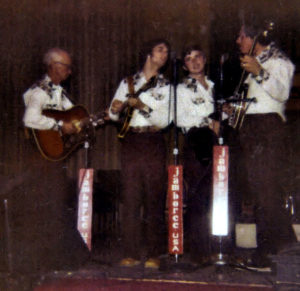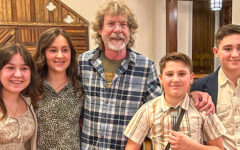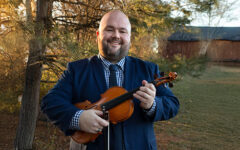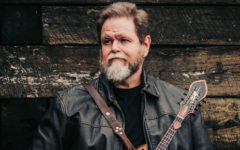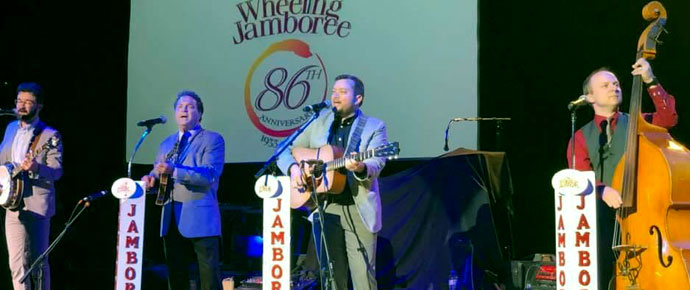
When Larry Stephenson was driving with his band to West Virginia earlier this month, he wasn’t expecting anything out of the ordinary. They were scheduled to perform on the Wheeling Jamboree, a show headlined by his old pal Marty Stuart, and Larry was looking forward to seeing the Capitol Theatre again.
As a teen, Stephenson used to perform there on the Jamboree with his dad as Larry Stephenson and the New Grass. This was while he was in high school, and just like today, Larry was playing mandolin and singing high tenor. He enjoyed seeing the old theater, renovated recently by the city of Wheeling, but just as he was about to start his set, Dave Heath, who was serving as MC, surprised them all by announcing that they were inducting Larry as a permanent member of the Wheeling Jamboree.
Talk about a big surprise!
When we spoke with Larry, he was still a bit overwhelmed.
“Dave Heath runs and is trying to revive the Jamboree. We’ve known him for several years. I had told him about my history there with my dad in the ’70s, and I had sent him some old photos of us there. I was in high school then, and we played some festivals in the region. My mom booked us, and I don’t even recall exactly how we ended up playing on the Jamboree. We were regular frequent guests, let’s say.
Mac Wiseman had run it in the ’60s, in the old Capitol Theater, a beautiful old theater on the Ohio River.
I never expected to be inducted as a member, and I see it as a great honor.
I applaud Dave for doing what he’s doing, bringing the acts back in there.”
For those who have followed bluegrass for a long while, The Wheeling Jamboree is an icon in the history of the music. Starting in 1933, the show offered live country and bluegrass over the air to audiences in West Virginia, Tennessee, Virginia, and Kentucky, plus the industrial midwest, with a powerful signal that could reach north to Cincinnati, Chicago, and other large cities where rural southerners had migrated for work.
Initially the show was a property of WWVA, which was a 5,000 watt station when the show launched, but was upgraded to 50,000 in 1942. With this increased reach, the Jamboree, airing live each Saturday night, became one of the most popular programs east of the Mississippi. The Saturday show went off the air during WWII, but the Jamboree was kept alive as a daytime offering, and returned to its former prominence in July of 1946.
And that was just in time for the advent of bluegrass. Wilma Lee & Stony Copper and The Lilly Brothers were regulars in the ’50s, along with the Bailey Brothers. Into the ’60s Jimmy Martin was a staple, as were The Stanley Brothers, Red Smiley, Charlie Moore & Bill Napier, The Shenandoah Cutups, and many others. But the advent of Elvis Presley and rock and roll music took its toll on the bluegrass acts on the Jamboree, and many were dropped in favor of young rockers.
By the 1990s, WWVA had changed ownership multiple times, and while they kept the popular Wheeling Jamboree, its production was eventually handed over to an outside company. When the station became a Clear Channel property, management of the shows turned over to the company’s Live Nation division.
In 2006, the Wheeling Jamboree was converted into a non-profit entity, known as Wheeling Jamboree, Inc. They opened WWOV radio in 2014, a low power FM station that reaches most of the Wheeling area.
Dave Heath has been on board throughout these changes, and continues to lead the show towards its second century. The team in place is determined to resurrect it to its previous glory, and has found tremendous support in Wheeling for its return.
“We are the current iteration of the WWVA Jamboree. We were in partnership with them up to the time that Clear Channel transitioned to iHeart Radio, and the divestiture of LiveNation from Clear Channel. We had been doing the show in the Capitol Theater, until December 2008, when the theater was closed for the show’s use during renovation.”
The Jamboree never went away, but it bounced around different venues and stations this past 12 years. In 2014, the FCC opened up a window for a low power FM station, and Dave applied for a license as the engineer. The current show now airs on WWOV, and a few other low power stations near Wheeling.
Heath said that he and a number of former staff members took over the show.
“Roger Hoard was the staff band leader and music director at the time, and came on to the board of the non-profit. Myself, local attorney Jeff McCammick, and some other business leaders formed a 501(c)3 to take over production of the show from roughly 15 different locations in Wheeling. We got back into the Capitol Theater in 2010, following renovations after it was sold to the city.”
The city brought the theater back up to modern code, and The Jamboree now rents it from the city. It is an expensive proposition, and they now do shows about once per quarter.
The Wheeling Jamboree had been a weekly show back in the day, and the current operators on the non-profit have made an arrangement with the convention and visitors bureau and the city to do a major show once a quarter. But they are also currently working to renovate their own building, just down the street from the Capitol, which seats about 600 people. They are raising funds now to that end.
Regarding the recent induction of Larry Stephenson, Dave says they are working to slowly rebuild a stable of regular performers.
“Since 2012 we have been inducting new members. There had been none since 1995, back when Brad Paisley was in our staff band. Larry Efaw is also a member, the first bluegrass artist inducted since Frank Necessary. Stacy Grubb as well.”
Larry told us that he was a bit sheepish about asking Heath that night what sort of responsibilities a member of The Wheeling Jamboree must shoulder, as he was so delighted to be asked. But Dave told him the only requirement was to try and play the show as often as he could. Deal!
And Stephenson still has his old Jamboree cowbell, a tradition that goes back to the early days of the program. Farmers back in the 1940s would bring a cowbell in to the show when they attended, and ring it during the live production so the folks back home could recognize the sound over the radio, know that their loved ones had made it to Wheeling safely, and were in the audience. It caught on so much that the Jamboree starting selling souvenir cowbells.
Long live The Wheeling Jamboree!
Larry Stephenson & The New Grass – Ed Stephenson, Larry Stephenson, Keith Sullivan, and Larry Jett

